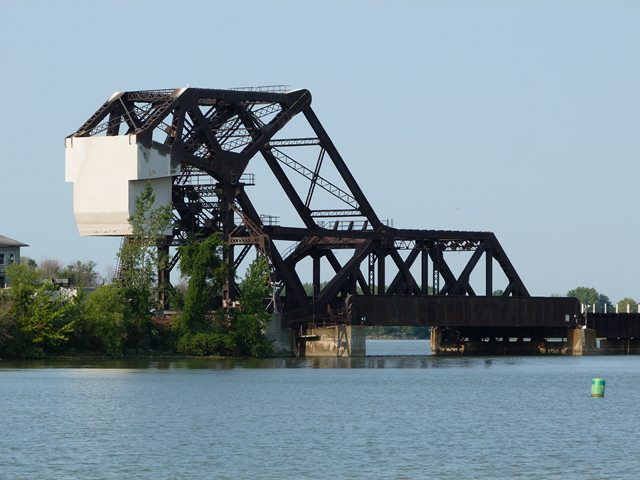We Recommend:
Bach Steel - Experts at historic truss bridge restoration.
BridgeHunter.com Phase 1 is released to the public! - Visit Now
Port Clinton Railroad Bridge

Primary Photographer(s): Nathan Holth
Bridge Documented: August 30, 2012
Port Clinton: Ottawa County, Ohio: United States
Metal Rivet-Connected Baltimore Through Truss, Movable: Single Leaf Bascule (Heel Trunnion) and Approach Spans: Metal Deck Girder, Fixed
1915 By Builder/Contractor: Pennsylvania Steel Company of Steelton, Pennsylvania and Engineer/Design: Strauss Bascule Bridge Company (Strauss Engineering Company) of Chicago, Illinois
Not Available or Not Applicable
118.0 Feet (36 Meters)
Not Available
Not Available
1 Main Span(s) and 3 Approach Span(s)
Not Applicable

View Information About HSR Ratings
Bridge Documentation
View A Detailed Engineering Article That Briefly Mentions This Bridge
View Historical Article About This Bridge
This bridge is a fascinating and unusual implementation of the Strauss heel-trunnion type of bascule bridge. The bridge was reported as the first four track railroad bascule bridge ever constructed, although another two four track bascule spans were constructed side by side (producing an eight track crossing) in the same year over Bronx Kills, New York City. This is a bridge that appears to no longer exist today. On the Port Clinton Railroad Bridge, the four tracks are arranged in an unusual manner. Two tracks are within the two truss lines, which is a traditional arrangement. The unusual aspect is that in addition, one track is on either side of the truss. In this sense, the outer tracks may be thought of as cantilevered out from the truss. However, the trusses alone do not carry the load of the outer tracks. The extreme edges of the bridge each carry a through plate girder, which also assist in supporting these outer tracks. The girders have their own main trunnions, separate of the main trunnions for the truss. However, it should be noted that the counterweight system for the bascule, including the counterweight trunnion, are not directly attached to the girders. Instead, they are attached only to the truss, like a traditional Strauss heel-trunnion without the outer tracks and girders would be. However, there are what could be described as stay rods, that run from each plate girder trunnion bearing out to the base of the support for the counterweight and counterweight trunnion. Another unusual detail is what appears to be best described as outriggers or buttresses that aid in supporting the counterweight and counterweight trunnion. These are clearly visible in the historical construction photo to the right.
An article in Volume 52 of the Railway Age Gazette (March 21, 1912) briefly mentioned the unusual design of this bridge as it discussed noteworthy bascule bridges of the time. It described it as follows:
"The second is a four-track structure for the Lake Shore & Michigan Southern over the Portage river at Port Clinton, Ohio, which follows the ordinary design of the heel trunnion type for the center pair of tracks, while the outer tracks are carried on floor beams extending from the bascule trusses to outer plate girders. These plate girders are supported by a heavy cross girder at each end of the span when the bridge opens, but come to rest on the piers when the bridge is closed."
This bridge has a high degree of historical and technological significance as an intact surviving example of a Strauss heel-trunnion bascule bridge. The fact that it has the unusual four-track design along with the equally unusual hybrid girder and truss design only add to the significance of the bridge. It appears to be an excellent demonstration of the impressive skill and creativity of the bridge's designer, Joseph Baermann Strauss.
![]()
Photo Galleries and Videos: Port Clinton Railroad Bridge
Bridge Photo-Documentation
Original / Full Size PhotosA collection of overview and detail photos. This gallery offers photos in the highest available resolution and file size in a touch-friendly popup viewer.
Alternatively, Browse Without Using Viewer
![]()
Bridge Photo-Documentation
Mobile Optimized PhotosA collection of overview and detail photos. This gallery features data-friendly, fast-loading photos in a touch-friendly popup viewer.
Alternatively, Browse Without Using Viewer
![]()
Maps and Links: Port Clinton Railroad Bridge
Coordinates (Latitude, Longitude):
Search For Additional Bridge Listings:
Bridgehunter.com: View listed bridges within 0.5 miles (0.8 kilometers) of this bridge.
Bridgehunter.com: View listed bridges within 10 miles (16 kilometers) of this bridge.
Additional Maps:
Google Streetview (If Available)
GeoHack (Additional Links and Coordinates)
Apple Maps (Via DuckDuckGo Search)
Apple Maps (Apple devices only)
Android: Open Location In Your Map or GPS App
Flickr Gallery (Find Nearby Photos)
Wikimedia Commons (Find Nearby Photos)
Directions Via Sygic For Android
Directions Via Sygic For iOS and Android Dolphin Browser
USGS National Map (United States Only)
Historical USGS Topo Maps (United States Only)
Historic Aerials (United States Only)
CalTopo Maps (United States Only)


